The World’s First (and Only) Truly Phonemic Alphabet
6. Word Examples in Some Common World Languages:
6.1 English
(Standard American pronunciation.)
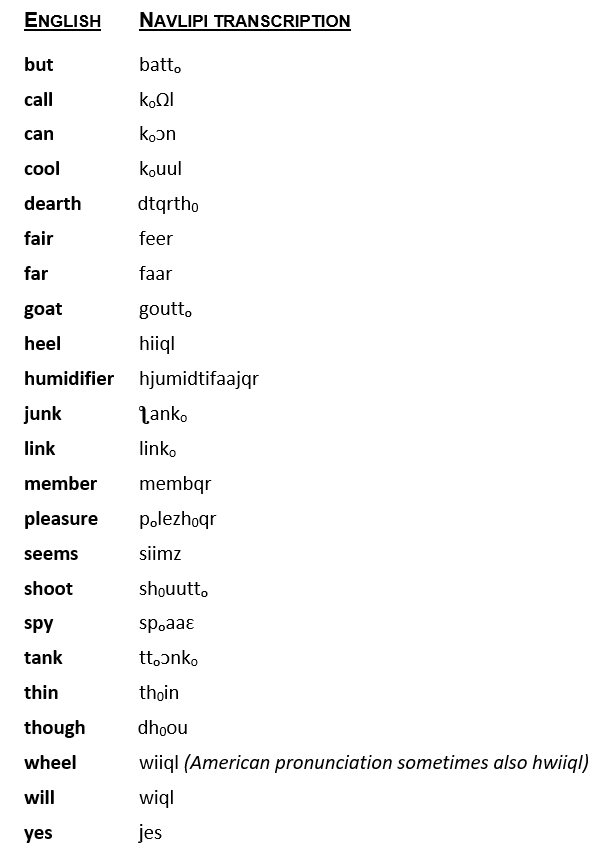
Red peppers are hot. Green peppers are sweet. I love okra and oranges. I love meat.
Redt pₒepₒrz aar haat. Griin pₒepₒrz aar swiit. Aaɛ lav okraa ᴐndt Ωrɛngiz. Aaɛ lav miit.
Mary had a little lamb, her fleece was white as snow. And everywhere that Mary went, the lamb was sure to go.
MƐri hᴐdt a littₒl lᴐmb, hqr fliis wΩs waaittₒ ᴐs snou. ᴐndt evriiwer dh0ᴐtto MƐri wentto, dh0q lᴐmb wΩz sh0uqr ttₒu gou.
Jack Sprat could eat no fat, his wife could eat no lean. And so, betwixt them both, they licked the platter clean.
ƪᴐko Spₒrᴐttₒ koudt iittₒ nou fᴐttₒ, hiz waaif koudt iittₒ no liin. Ɔndt sou, bittₒwikosttₒ dh0em bouth0, dh0Ɛi likottₒ dh0a pₒlᴐttₒr kliin.
6.2 Mandarin
For the Latin transcription of the four tones of Mandarin, a number, from 1 to 4 is used. In the NAVLIPI transcription, for the four tones, the NAVLIPI tone marks are (in parentheses in green): 1st tone, high and level (|); 2nd, rising (⌡); 3rd, falling-rising (⌠ᴗ); 4th, low, falling (┌).
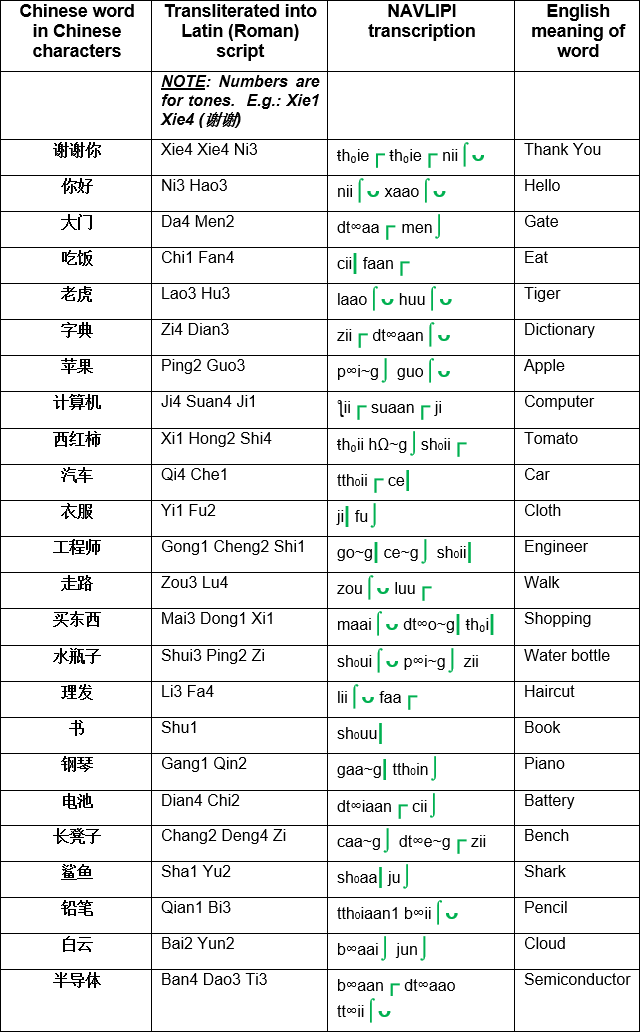
Chinese:
玛丽有一只小羊羔,她有一身雪白的毛, 无论玛丽到哪里, 羊羔总是跟着跑.
Latin Transliteration in Mandarin (tone marks as numbers):
Ma3 Li4 You3 Yi1 Zhi1 Xiao3 Yang2 Gao1, Ta1 You3 Yi1 Shen1 Xue3 Bai2 De Mao2, Wu2 Lun4 Ma3 Li4 Dao4 Na3 Li3, Yang2 Gao1 Zong3 Shi4 Gen1 Zhe Pao3.
NAVLIPI Transcription (tone marks in green):
[ Recap of tone marks: 1st tone, high and level (|); 2nd, rising (⌡); 3rd, falling-rising (⌠ᴗ); 4th, low, falling (┌). ]
maa⌠ᴗ lii┌ j ou⌠ᴗ ji| zh0i| ŧh₀iaao⌠ᴗ jaa~g⌡ gaao| tt∞aa jou⌠ᴗ ji| sh0en| ŧh₀ue⌠ᴗ b∞aai⌡ dt∞e maao⌡ wuu lun┌ maa⌠ᴗ lii⌠ᴗ dt∞aao┌ naa⌠ᴗ lii⌠ᴗ, jaa~g⌡ g aao| zo~g⌠ᴗ sh0ii┌ gen| zh0e b∞aao⌠ᴗ
English Translation:
Mary had a little lamb, her fleece was white as snow. And everywhere that Mary went, the lamb was sure to go.
6.3 Hindi
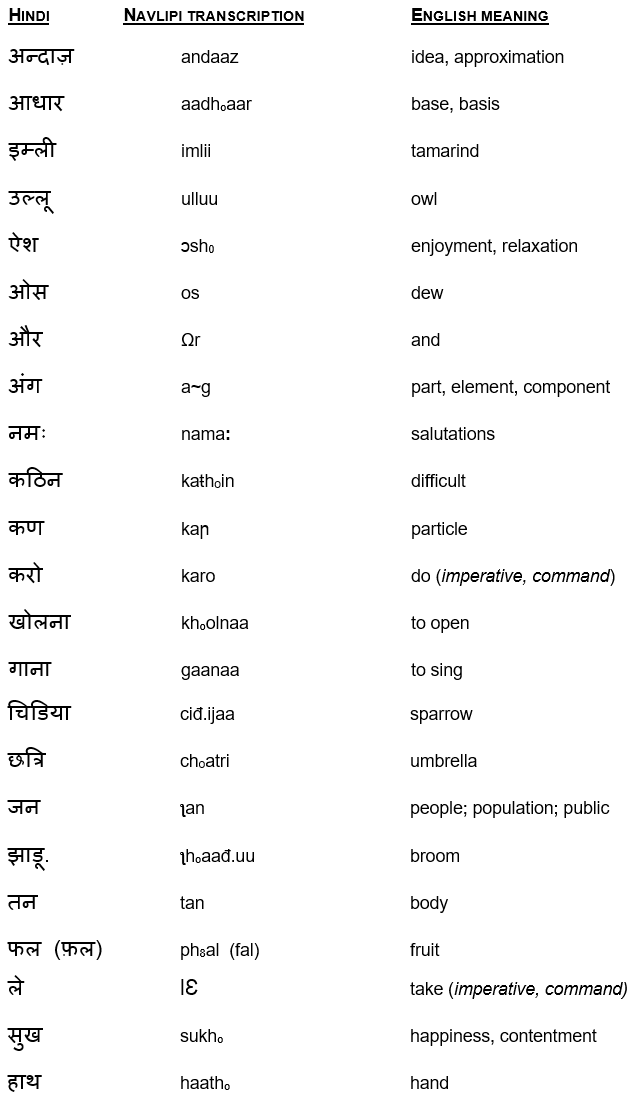
Short sentences:
Hindi in Dewanaagari and Navlipi scripts
उन्होंने प्रधानमंत्री का धन्यवाद किया।
Unho~nƐ pradhoaanmantrii kaa dhoanjavwaad kijaa.
उन्होंने कहा कि पहली गोली भारतीय सेना नहीं चलाएगी,
Unho~nƐ kaahaa ki pehelii golii Bhoaaratiija sƐnaa nahii~ calaaƐgii,
लेकिन अगर हम पर हमला हुआ तो गोलियां गिनी नहीं जाएंगी।
lƐkin agar ham par hamlaa huaa to golijaa~ ginii nahii~ ƪaaƐ~gii.
उन्होंने भारत को अब तक की सबसे सशक्त स्थिति में लाने के लिए
Unho~nƐ Bhoaarat ko ab tak kii sabsƐ sash0akt sthoiti mƐ~ laanƐ kƐ lijƐ
प्रधानमंत्री का धन्यवाद किया।
pradhoaanmantrii kaa dhoanjavwaad kijaa.
साथ ही उन्होंने इस स्थान पर एक केन्द्र विकसित करने की बात भी कही।
Saatho hii unho~nƐ is sthoaan par Ɛk kƐndrq vwikasit karnƐ kii baat bhoii kahii.
English meaning
He/She thanked the Prime Minister. He/She said that the first shot would not be fired by the Indian Army, but if there were an attack on us, then the shots would not be counted. He/She thanked the Prime Minister for bringing India to its strongest status thus far. He/She also brought up the issue of developing a center (base) at this location.
6.4 Spanish (Standard Castellano pronunciation)
(NOTE: It will be noticed that, because Spanish is written most phonetically and closest to the original Latin phonetic transcription, the difference between the Latin and NAVLIPI transcriptions is the smallest among European languages!)
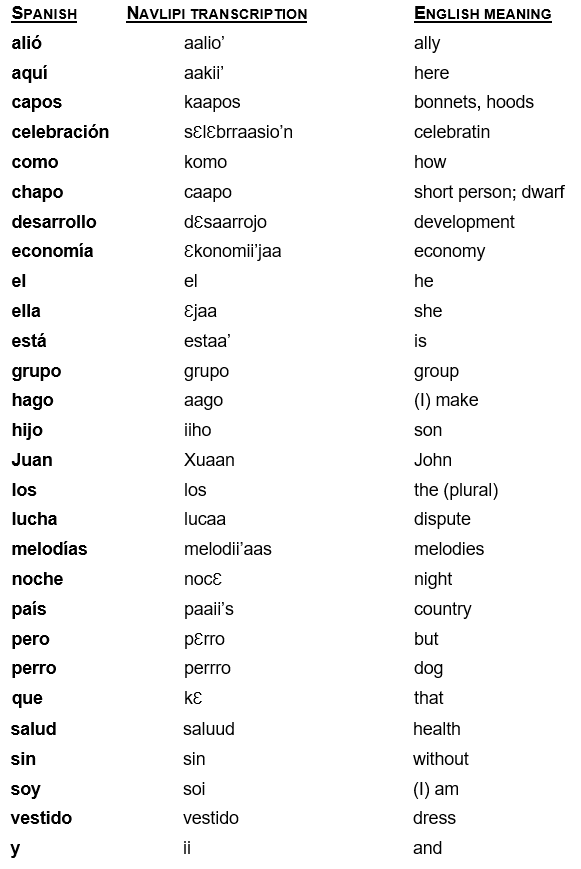
Los científicos han intentado, durante cuatro siglos, entender las propiedades de
Los sientii’fikos haan intentaado, durraantƐ kwaatrro siiglos, entendƐr las prropiƐdaadƐs dƐ
esas estructuras, pero solo ahora la tecnología ha permitido arrojar luz,
Ɛsaas estrrukturraas, pƐrro solo aaorraa laa teknolohii’aa haa perrmitiido arrohaarr lus,
literalmente, sobre el problema. Los científicos utilizaron un
litƐrraalmƐntƐ, sobrrƐ el prroblƐmaa. Los sientii’fikos utilisaarron un
polariscopio de transmisión —un tipo de microscopio que mide la doble refracción
polaarriskopio dƐ traansmisio’n – un tiipo de miikrroskopio kƐ miidƐ laa doblƐ rrƐfrraaksio’n
en un objeto transparente axisimétrico, como las lágrimas
en un obheto trraanspaarrentƐ aaksisimƐ’trriko, komo laas laa’grrimaas
English meaning
Scientists have tried to understand the properties of these structures for four centuries, but only now has technology allowed them to literally shed light on the problem. Scientists used a transmission polariscope — a type of microscope that measures double refraction on an axisymmetric transparent object, such as tears.
6.5 Arabic
Original Arabic:
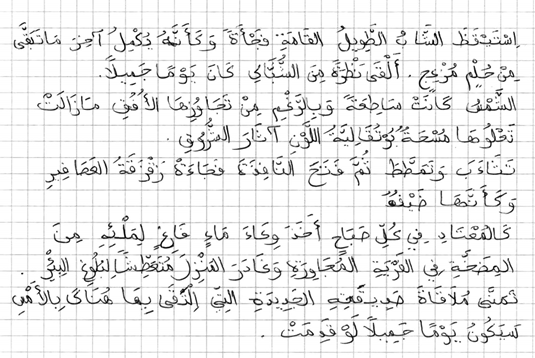
Approximate Latin (bold) and NAVLIPI (italics) Transcriptions (Syrian pronunciation):
Estaeyaqata eshaabu attawilu alqamati faejae‘aeten wo kaannau yukmelu
ᴐ stᴐaak..ataa esh0aabu at..aawilu alk..amati fᴐƪᴐ:ᴐten wo kaannaau jukmelu
a’-kherae maetaebaeqae men holmen mozeshen. Alqae nalhraten miinaa ae’shoubeki.
a: axɛrrᴐ mᴐtᴐbᴐk..ᴐ men holmen mozesh0e~. Alk..ᴐ nalhoraten miinaa ᴐᴐ: sh0ubeki.
O kaanaa yaaoumen jaemilaen. Ashaemsu kaenet saetaataan waa berraaghme
O kaanaa jaaoumɛ~ ƪemilᴐn. A sh0ᴐmsu kᴐnet sᴐt aa: taan waa berraaƹmɛ mɛ
mean taajaawezehae aloufouq mmmae zaelet taanluhaa maashaatun burtukaliiaatu
mɛaan taaƪaawɛzɛhᴐ aloufouk.. m00mᴐzᴐᴐlet taa~luhaa maas haatun burrtukaliiaatu
allaawne aalhaafaaraa shuruq. Taethaeaabae wae taemaataataa.
allaaw nɛ alhoaafaavaa sh0uruk.. . Te th0ᴐᴐ aa bᴐᴐ wᴐ tᴐ maataataa.
Thuma faetaehae aelnaefelhata, faja’at zoqzoqaetu al’assaefiire waa.
Th0uma fet ᴐᴐhᴐᴐ ᴐlnᴐ fɛth0ta, faƪa:at zok..zok..ᴐtu al:assᴐfiirrɛ waa.
Kae’anna-haa thaay-fuun. Kalmoaataede fi kolli saabaehii~ aakhaa thae
Kᴐ:annahaath0aai fuu~ . Kalmoaatᴐdɛ fi kolli saabᴐᴐhe aaxaa th0ᴐ
weaeae maein faereghiin limalehe miim almiitaekhate fii alkaryate al mujaaweraatea
wɛ ᴐ:ᴐ mᴐ:in fᴐrrɛgiin limaleɛhɛ miim almiitᴐxatɛ fii alkarjate al muƪaa we rraatɛa
wa waatea ghadaaraa almaenziilae ‘muuta’aeteashen liibulughi al biaeri.
wa waatɛa gadaarraa al mᴐnziilᴐ :muut:ta:ᴐtɛsh0en liibulugi albiᴐri .
Ta-mnae mulaeqaatea sadiikaetiihe aljaediidaetii. Allaatii Iltaeqae biinaehae hunaekae
Ta manᴐ mulᴐk..ᴐtɛa sadkiikɛtiihɛ alƪᴐdiidᴐtii . Allaatii iltᴐk..ᴐ biinᴐhᴐ hunᴐkᴐ
billaemsi. Sa-ya-kunu yaau-maen jaamii laen lou qaedii mat.
billᴐmsi . Sa jakunu jaaumᴐn ƪaamiilᴐn lou k..ᴐdiimat .
English meaning (translation):
A man and a woman go out for a walk with their two beautiful children, a girl and a boy, whom they love very much. It is a sunny day. They sit down on the grass below a shady tree. The children play nearby at the bank of a stream. The boy yells. He is hurt. His sister runs to their parents to tell them. She is worried. The parents decide it is time to go home. They gather their belongings, get the children, and head home.
6.6 Tamil
Short phrase example:
TAMIL: தாய் சொல்லை தட்டாதே
NAVLIPI: Toaai sollai toaŧŧaatoe
English translation: Always heed a mother’s command.